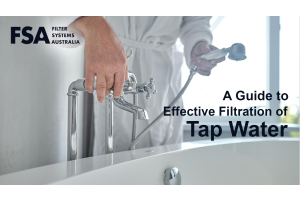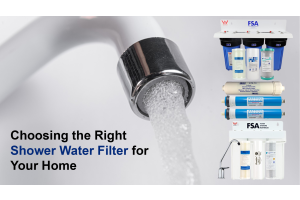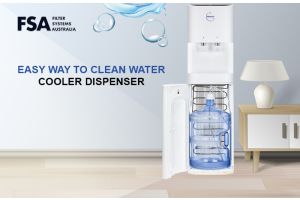

Is the water coming from your tap good enough to drink or should you invest in a water filter to get better quality water from every tap turned on?
While turning a tap on, if you ever wondered about what quality of the water that comes out, you are not alone! Moreover, you can be confident as the water is tested thoroughly and potential contaminants are removed through chlorine disinfection before it reaches your tap. What you might need to worry about is if it is good enough to drink every day without any impact on health and most importantly, if it beats the quality of filtered water?

To know this, you have to understand how water is treated.
Water treated by the local water authority passes through a rigorous four stage process to eliminate any harmful contaminants and become clean enough to be consumed.
- Coagulation and Flocculation: This process uses chemicals that combine with related waterborne compounds to form large particles, which creates a solid mass called floc.
- Sedimentation: As floc is denser than water, it floats to the bottom of the water treatment tank during a sedimentation process, settling in a removable layer.
- Filtration: Once the floc layer has been separated, the residual clear water passes through sand, gravel or charcoal filters that take out any type of contaminants or impurities.
- Disinfection: This is the last water treatment stage where water is disinfected with chlorine to remove remaining pathogens and keep the water supply clean as it passes through the pipeline.
Safe and treated tap water widely uses additives like chlorine which you can often smell or taste. If the smell or taste of chlorine bothers you, installing a water filter at the tap can help. But first you must decide what you actually want to filter out as different water filters are designed to remove different contaminants. So, before investing in any water filter, do your research, test your water quality, compare different options on the basis of filtration technologies and prices and then decide which water filter model best suits your needs.
Why you actually need a water filter?
Tap water is accessible to all and most Australians generally don’t worry about getting sick from drinking tap water as proper disinfectants are used by water supply authorities to purify it. As mentioned earlier, water authorities use a 4-way process for delivering safe drinking water starting from coagulation to sedimentation, filtration and disinfecting to ensure water reaches to every home without any microorganisms.
The downside of drinking safe treated water is the lingering taste and smell of disinfectants. To get rid of that odd smell and taste, you can fill up a jug with tap water and leave it to sit for a couple of hours for the disinfectant smell and taste to gradually dissipate. But getting a water filter installed will make sure you don’t have to wait around for the taste and smell of the disinfectant to disappear on its own.
What About Bottled Water? Is it Safe to Use?
Though many people consider bottled water a healthier and more convenient source than tap water, bottled water is not subject to nearly the same level of scrutiny and regulation. In fact, it is also not good for the environment considering the transport energy, refrigeration energy and the overall energy footprint involved in obtaining the water from the source and transferring it into bottles; only 35% actually gets recycled and remaining bottles end up in the landfill.
Recently, councils in some areas have made the decision to discourage the use of bottled water. As the negative effects of bottled water continue to grow and affect the environment, people are giving up the convenience of drinking bottled water sourced from the market and adopting the idea of preparing their own re-usable bottle from the tap or a filtered source.
CHECK CERTIFICATION
While searching your perfect water filters, you may come across a few models that claim to meet highest performance standards but are not certified.
So, should you simply overlook the certification and invest in those models based on their claim? If you want to get the most out of your investment, then “No”, you shouldn’t. If you are treating a potential health threat, you should be able to count on the filter’s performance and the certification will provide you the guarantee and peace of mind you need.
Even if your tap water tastes or smells okay, looking for a certified product is still a good idea.
CONTAMINANTS AND ADDITIVES
Tap water includes many impurities, both-natural and artificial. Though some are harmless and just affect the taste and smell of water, other impurities can cause an immediate infection or slowly affect your health over a long period of time.
MICROBIOLOGICAL RISKS
Supplying water to homes that’s free from pathogenic micro-organisms is the most important task for water authorities as no matter what, some micro-organisms will remain in the water even after disinfection.
Most pathogenic bacteria found in water come from contamination by human or animal faeces and chlorine disinfection kills all such bacteria. However, that’s not the case with protozoa and viruses as these can resist disinfection and some of its microorganism can even make you sick.
WATER ISSUES
Except for lead and micro-organisms, most contaminants found in water just affect the aesthetic nature of water and don’t create such big health problems unless they are present in high concentrations.
Take a look at the table to know the cause of specific (aesthetic) water issues.
| PROBLEM | SYMPTOM | POSSIBLE CAUSE |
|---|---|---|
| Discoloured water | Cloudy black, red brown or yellow | Turbidity (fine suspended particles) (A) Hydrogen sulphide, manganese Iron Iron, humic and tannic acids |
| Unusual taste of odour | Rotten egg Metallic Salty Septic, musty, earthy Bleach-like Petrol | Hydrogen sulphide pH (acid-alkaline balance) is too low, iron, zinc, copper, lead Total dissolved solids, chloride Bacteria or algae Chlorine New housing uses plastic piping from source to house - paints used soak from the earth to piping and leak in |
| Reddish brown-slime in water and pipes | Slime | Iron (bacteria that feed on the iron is the reason behind the cause of slime) |
| Corrosive water | Deposits, pitting of plumbing | pH, copper, lead |
| Stained plumbing and clothes | Red or brown Black Green or blue | Iron manganese copper |
Do any of the issues stated above seem relatable? If yes, you need to install a water filter without thinking much.
To make it easier for you, we have created a table mentioning different types of filters with pro and cons of each.
WATER FILTER PROFILES
| TYPE | PROS | CONS |
|---|---|---|
| JUG FILTER | Convenient, small, replace filters and easy to use | Some of the jug filters are slow, prone to clogging and have shorter filter lives, meaning higher ongoing costs. |
| FAUCET MOUNTED | Most convenient at tap filter, easy to use and replace filters. Easily swap between filtered and non-filtered water | Slow water flow and cannot be used on all taps |
| COUNTER TOP | Filters large amounts of water without plumbing modification. Unlike jug or faucet mounted filters, it is less likely to clog. | Clutters countertop and cannot be used on all faucets. |
| UNDER-SINK | Filters large amounts of water without | Requires plumbing modification as it takes |
| cluttering up countertop or attaching to existing tap. Less likely to clog than jug or faucet mounted filters. | up under-sink space. Expensive one |

Besides, there are other filter options as well like shower water filter, whole house filters or ones built into fridge.
FILTER MEDIUMS
All the filter systems mentioned above can have different types or combination of filter mediums. Your choice specifically depends on what you want to get rid of.
- Filtration/Adsorption: This one helps improve odour, taste and unwanted particles in the water.
- Softeners: It is helpful in reducing the large amounts of minerals that make the water become hard.
- UV Treatment: Uses UV light to disinfect water and works on fairly clear water. Unclear water doesn’t allow the light to penetrate sufficiently.
- Reverse Osmosis: Water passes through a thin membrane under high pressure to remove most of contaminants from the water.
The real question now is, do water filters really work? How can you be sure these filters don’t false advertise and actually do what they say?
The best way is to look for certification. The NSF International provides a range of certifications for products that involve initial and periodic testing:
- NSF 42 covers aesthetic effects such as chlorine, taste, odour and particles.
- NSF 53 covers health effects such as cysts, a range of organic chemicals like pesticides and heavy metals.
The Australian standard AS/NZS4348 includes several contaminants like taste, odour, microbiological and chemical impurities. There are also standards for water softeners (NSF 44), reverse osmosis (NSF 58).
That’s it. Once you keep all these things in mind, you will be able to make the right choice.
To sum up, it is always a good idea to install a water filter at your place and have access to clean and safe drinking water to avoid associated health ailments.

Besides, to buy best water filters or any related advice, get in touch with one of our water specialists. At Filter System Australia, we offer everything from water filters to bottled water dispensers and purifiers at best rates in Australia.



